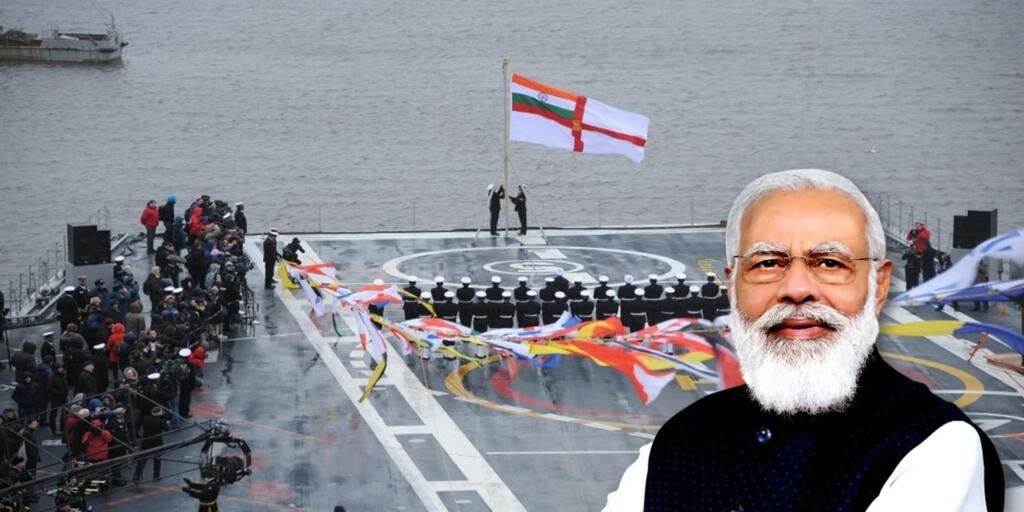Gone are the days when India had a colonized representation. The rule of the ‘Goras’ is now done and dusted. It’s time for the Indian civilization to leave the colonial mindset and emerge as the next superpower of the world. And with another decolonizing effort, the Indian Navy is all set to get its new ensign with the commissioning of an indigenous aircraft carrier.
India is all set to replace the colonial symbols
With the commissioning of India’s first-ever indigenous aircraft carrier, INS Vikrant, on September 2, the Indian Navy is all set to celebrate an additional victory with the adoption of a newly developed naval ensign (flag). It will be unveiled by Prime Minister Narendra Modi during an event organized in Kochi.
In light of welcoming the decolonized naval flag, the Prime Minister’s office stated that the new navy ensign would do “away with the colonial past… befitting the rich Indian maritime heritage.” However, the new naval ensign has not been made public yet.
The launching of a new navy ensign will be a replacement of the present ensign or flag that carries the Saint George’s Cross with the Tricolour in the top left corner of the flag. It will be a successor to the pre-Independence ensign of the Indian Navy which carried the red George’s Cross on a white background with the Union Jack of the United Kingdom on the top left corner.
Understanding the history of Indian Navy ensigns, it’s pertinent to note that even after independence, the Indian defense forces continued with British colonial flags and badges. It was until January 26, 1950, that a new ensign was adopted with a more Indianised pattern. However, the difference made to the flag was just that the Union Jack was replaced with the Tricolour, and the George’s Cross was retained even further.
While understanding the significance, the red cross on a white background is known as the “Saint George’s Cross”. It is named after a Christian Warrior Saint who was believed to have been a crusader during the third crusade. This cross also serves as the flag of England which is a constituent of the United Kingdom. The flag was adopted by England and the city of London in 1190, in order to identify the English ships entering the Mediterranean.
Read more: Indian Navy will soon be a force to reckon with
Years that marked the transformation of Indian Navy ensigns
It’s not the first time that the Indian Navy is welcoming a new ensign. Under the Atal Bihari Vajpayee government in 2001, the George’s Cross was replaced with the naval crest in the middle of the white flag while the Tricolour retained its place on the top left corner. The idea to change the Navy ensign came from Vice Admiral Vivian Barboza in the early 1970s.
On the other hand, in 2004, it was again changed back to the Red George’s Cross. This was in the aftermath of numerous complaints against the new flag that it was indistinguishable because the blue of the Navy crest merged with the skies and the sea. Thus, a change was made in the flag and the red George’s Cross imprinted the state emblem derived from the Lion Capital of Ashoka in the middle.
In the year 2014, the Indian Navy’s flag was again changed with the inclusion of the words “Satyamev Jayate”, which is also the national motto of India. It was engraved on the flag below the Ashoka emblem in the Devanagri script.
Keeping these historical transformations in mind, it is imperative to note that the year 2022 will also be marked by another such change in the history of the Indian Navy. The adoption of a new naval ensign will apparently mark the removal of the red Saint George’s Cross.
A step to decolonize India
This recent announcement for the adoption of a new naval ensign is just the reiteration of Prime Minister Narendra Modi’s independence day speech. From the ramparts of Red Fort, PM Modi stressed the need of decolonising India. He urged everyone to remove the traces of slavery within and around them so that India could completely eliminate the traces of servitude.
Moreover, under the leadership of Prime Minister Narendra Modi, India is stepping ahead to decolonize itself and set its own benchmark in every domain, instead of following the western world. Earlier, the Defence Ministry decided to drop the Christian hymn ‘Abide by Me’ by Scottish Anglican poet Henry Francis Lyte, to be played at the Beating Retreat Ceremony in January this year.
This clearly derives the conclusion that India is gradually stepping toward decolonization. It is all set to establish itself as a superpower while removing every aspect reflecting the colonial mindset.
Support TFI:
Support us to strengthen the ‘Right’ ideology of cultural nationalism by purchasing the best quality garments from TFI-STORE.COM
